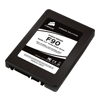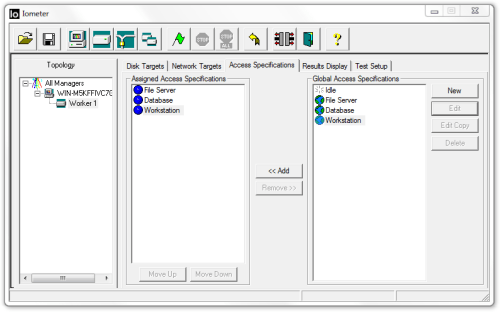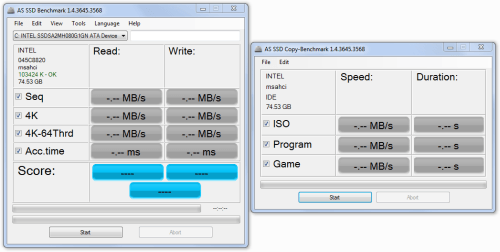- Qualcomm Launches Snapdragon 4 Gen 2 Mobile Platform
- AMD Launches Ryzen PRO 7000 Series Mobile & Desktop Platform
- Intel Launches Sleek Single-Slot Arc Pro A60 Workstation Graphics Card
- NVIDIA Announces Latest Ada Lovelace Additions: GeForce RTX 4060 Ti & RTX 4060
- Maxon Redshift With AMD Radeon GPU Rendering Support Now Available
Corsair Force F90 90GB Solid-State Drive Review

There couldn’t be a better time than the present to purchase an SSD, and on the same token, it’s also a strange time. Performance drives cost the same as budget drives, and a perfect example of this is Corsair’s Force F90. It’s priced-right, offers incredible performance, and makes perfect use of its SandForce SF-1200 controller.
Page 4 – Synthetic: Iometer & AS SSD
Iometer 2006.07.27
Originally developed by Intel, and since given to the open-source community, Iometer (pronounced “eyeawmeter”, like thermometer) is one of the best storage-testing applications available, for a couple of reasons. The first, and primary, is that it’s completely customizable, and if you have a specific workload you need to hit a drive with, you can easily accomplish it here. Also, the program delivers results in IOPS (input/output operations per second), a common metric used in enterprise and server environments.
The level of customization cannot be understated. Aside from choosing the obvious figures, like chunk sizes, you can choose the percentage of the time that each respective chunk size will be used in a given test. You can also alter the percentages for read and write, and also how often either the reads or writes will be random (as opposed to sequential). I’m just touching the surface here, but what’s most important is that we’re able to deliver a consistent test on all of our drives, which increases the accuracy in our results.
Because of the level of control Iometer offers, we’ve created profiles for three of the most popular workloads out there: Database, File Server and Workstation. Database uses chunk sizes of 8KB, with 67% read, along with 100% random coverage. File Server is the more robust of the group, as it features chunk sizes ranging from 512B to 64KB, in varying levels of access, but again with 100% random coverage. Lastly, Workstation focuses on 8KB chunks with 80% read and 80% random coverage.
Because these profiles aren’t easily found on the Web, with the same being said about the exact structure of each, we’re hosting the software here for those who want to benchmark their own drives with the exact same profiles we use. That ZIP archive (~3.5MB) includes the application and the three profiles in an .icf file.



Iometer is one application that can replicate the most brutal conditions for solid-state drives, although for a traditional hard disk such scenarios would be simply dreadful. These scenarios in particular are why vast arrays of 15,000RPM SCSI drives are utilized in high and especially highly random I/O applications.
When having to seek to random data a solid-state drive has an inherent advantage. It can look up a read request in as little as 0.1 of a millisecond, as opposed to 7ms for a 10,000RPM drive or 12-14ms for most consumer level 7,200RPM hard drives. Compared to any kind of mechanical hard disk, these near instantaneous access times are what give SSDs most of their mojo, and why a difference in system responsiveness between one a system with an SSD and one without can by physically noticed just through normal use.
Iometer testing showcases which of these SSD controllers are the most capable at servicing numerous small reads and/or write requests concurrently. Think of the SSD controller as the drive’s own CPU, as that is basically what it does; even hard disk drives have a controller. What this test focuses on is testing how much it takes to max out and saturate the controller in read/write requests.
As these Iometer tests are designed to max out the SSD we are left with some extremely large variances in results between our contenders, but for those looking for a quick idea to put them in a context: anything around the old Vertex Turbo drive or higher is more than sufficient. Anything higher, while impressive, only translates into higher read/write bandwidth. Which is the same thing as saying while the Bugatti Veyron can exceed 250mph, anything above 80mph doesn’t mean a whole lot unless you have a dedicated racing strip to use it on.
The same is true with SSDs, we are reaching a point where higher IOPS is great to have, but unless users have a dedicated workload that actually requires it, anything extra is superfluous for typical enthusiast desktop use. All that being said, it is still nice to have and as expected, the SandForce SF-1200 controller in the Corsair Force SSD has power aplenty under its hood.
AS SSD
As the name might hint, AS SSD is a nifty little program written exclusively for SSDs. It can be run on mechanical hard drives, but be warned that what should take minutes will take over an hour to benchmark! This handy little tool provides several read/write tests at important file sizes, but also includes a benchmark to simulate the transfer of three types of large files.
We selected this program for its precision, ability to generate large file sizes on the fly, and that it is written to bypass Windows 7’s automatic caching system. The tool does not bypass any onboard cache.





AS SSD is an application that was written specifically for solid-state drives as an easy tool for any computer user to download and run for some quick, comparable results. We utilize it for its appropriate focus on small file operations and because it bypasses Windows 7’s automatic caching system in the process.
It is interesting to note that SandForce drives don’t fare particularly well in this program, and we finally have an answer as to why. It appears to be because of the type of data being written isn’t compressible. SandForce drives are unique in how they function; they attain their stellar performance through data compression. However if the data being written is already highly compressed (such as an MP3 or JPEG ) then it will offer lower performance. This is why the OCZ Revo, which is unarguably fast enough to exceed the SATA 3Gbps interface and had to be put on a PCIe card, had such trouble with the write portions of the tests. As such we can say these would be the worst-case scenario in terms of possible performance.
However, as most users don’t plan to utilize their SSD as an expensive file storage drive we don’t think these results should be any sort of deterrent, especially given both the read and write performance is still in another universe compared to mechanical drives. The worst-case scenario would be few and far between if utilized as an OS and Program Files drive.
Support our efforts! With ad revenue at an all-time low for written websites, we're relying more than ever on reader support to help us continue putting so much effort into this type of content. You can support us by becoming a Patron, or by using our Amazon shopping affiliate links listed through our articles. Thanks for your support!






